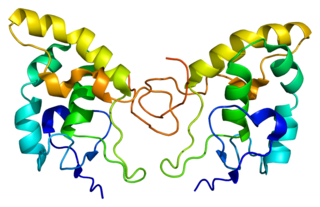The Apelin Receptor (APLNR, also known as APJ) is a G protein-coupled receptor. [5] APLNR possesses two endogenous ligands which are APELIN [6] [7] [8] and ELABELA. [9] [10] The structure of APLNR was resolved in 2017 [11]
The Apelin Receptor (APLNR, also known as APJ) is a G protein-coupled receptor. [5] APLNR possesses two endogenous ligands which are APELIN [6] [7] [8] and ELABELA. [9] [10] The structure of APLNR was resolved in 2017 [11]

C-X-C chemokine receptor type 4 (CXCR-4) also known as fusin or CD184 is a protein that in humans is encoded by the CXCR4 gene. The protein is a CXC chemokine receptor.

Apelin is a peptide that in humans is encoded by the APLN gene. Apelin is one of two endogenous ligands for the G-protein-coupled APJ receptor that is expressed at the surface of some cell types. It is widely expressed in various organs such as the heart, lung, kidney, liver, adipose tissue, gastrointestinal tract, brain, adrenal glands, endothelium, and human plasma.

Artemin, also known as enovin or neublastin, is a protein that in humans is encoded by the ARTN gene.

MAS proto-oncogene, or MAS1 proto-oncogene, G protein-coupled receptor, is a protein that in humans is encoded by the MAS1 gene. The structure of the MAS1 product indicates that it belongs to the class of receptors that are coupled to GTP-binding proteins and share a conserved structural motif, which is described as a '7-transmembrane segment' following the prediction that these hydrophobic segments form membrane-spanning alpha-helices. The MAS1 protein may be a receptor that, when activated, modulates a critical component in a growth-regulating pathway to bring about oncogenic effects.

Bradykinin receptor B2 is a G-protein coupled receptor for bradykinin, encoded by the BDKRB2 gene in humans.

Sphingosine-1-phosphate receptor 3 also known as S1PR3 is a human gene which encodes a G protein-coupled receptor which binds the lipid signaling molecule sphingosine 1-phosphate (S1P). Hence this receptor is also known as S1P3.

G protein-coupled receptor 1, also known as GPR1, is a protein that in humans is encoded by the GPR1 gene.

Neuropeptides B/W receptor 1, also known as NPBW1 and GPR7, is a human protein encoded by the NPBWR1 gene. As implied by its name, it and related gene NPBW2 are transmembranes protein that bind Neuropeptide B (NPB) and Neuropeptide W (NPW), both proteins expressed strongly in parts of the brain that regulate stress and fear including the extended amygdala and stria terminalis. When originally discovered in 1995, these receptors had no known ligands and were called GPR7 and GPR8, but at least three groups in the early 2000s independently identified their endogenous ligands, triggering the name change in 2005.

Neuropeptides B/W receptor 2, also known as NPBW2, is a human protein encoded by the NPBWR2 gene.

Angiotensin II receptor type 2, also known as the AT2 receptor is a protein that in humans is encoded by the AGTR2 gene.

G protein-coupled receptor 15 is a protein that in humans is encoded by the GPR15 gene.

Frizzled-8(Fz-8) is a protein that in humans is encoded by the FZD8 gene.

Sphingosine-1-phosphate receptor 4 also known as S1PR4 is a human gene which encodes a G protein-coupled receptor which binds the lipid signaling molecule sphingosine 1-phosphate (S1P). Hence this receptor is also known as S1P4.

Atypical chemokine receptor 3 also known as C-X-C chemokine receptor type 7 (CXCR-7) and G-protein coupled receptor 159 (GPR159) is a protein that in humans is encoded by the ACKR3 gene.

G-protein coupled receptor 3 is a protein that in humans is encoded by the GPR3 gene. The protein encoded by this gene is a member of the G protein-coupled receptor family of transmembrane receptors and is involved in signal transduction.

Low-density lipoprotein receptor-related protein 6 is a protein that in humans is encoded by the LRP6 gene. LRP6 is a key component of the LRP5/LRP6/Frizzled co-receptor group that is involved in canonical Wnt pathway.

Type-1 angiotensin II receptor-associated protein is a protein that in humans is encoded by the AGTRAP gene.

NPW is a gene that in humans encodes Neuropeptide W protein.

Guanine nucleotide-binding protein subunit alpha-11 is a protein that in humans is encoded by the GNA11 gene. Together with GNAQ, it functions as a Gq alpha subunit.

ELABELA is a hormonal peptide that in humans is encoded by the APELA gene. Elabela is one of two endogenous ligands for the G-protein-coupled APLNR receptor.